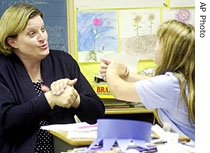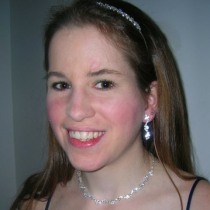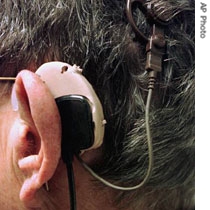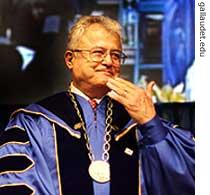VOA慢速英语 2008 0519b
搜索关注在线英语听力室公众号:tingroom,领取免费英语资料大礼包。
(单词翻译)
THIS IS AMERICA - Inside the Complex Worlds of Deafness and Deaf Culture in America
Hearing technology offers more hope than ever. Yet the devices are not always welcomed. Also, how one young woman is learning to accept herself for who she is. Transcript1 of radio broadcast:
18 May 2008
VOICE ONE:
Welcome to THIS IS AMERICA in VOA Special English. I'm Barbara Klein.
VOICE TWO:
And I'm Steve Ember. This week on our program, we explore deaf culture in America.
(MUSIC)
VOICE ONE:
 |
| A teacher and her student sign the word ''turtle'' at a West Virginia school |
More than three hundred million people live in the United States. By some estimates, about one million of them are deaf and almost ten million are hard of hearing.
A few years ago, Gallaudet University researcher Ross Mitchell wrote a paper about these estimates from findings by the Census2 Bureau. The estimates suggest that less than one in twenty Americans is deaf or hard of hearing.
But as he pointed3 out, these findings are limited to people who report difficulty hearing normal conversation. They do not include the larger population of people with hearing loss who have difficulty hearing other sounds.
VOICE TWO:
Some loss of hearing is normal as people age. More than half the people with hearing loss or deafness are sixty-five or older. Less than four percent are under eighteen. But many things can cause hearing loss, including a head injury or noises like gunfire or loud music. In some cases, unless they have a hearing test, people may not recognize the damage until later in life.
Some people have become deaf after taking powerful antibiotics4 or anti-inflammatory drugs. Cancer drugs can also sometimes damage hearing.
The same is true with infections. Meningitis is the most common cause of hearing loss among children in the United States.
And deafness can be genetic5. One genetic cause of hearing loss is a nervous system disorder6 called neurofibromatosis. Growths develop on nerves, especially those in the ear.
VOICE ONE:
 |
| Anne Shigley, 20, went deaf from a genetic condition two years ago |
Anne Shigley is a college student with neurofibromatosis type two. She began to lose her hearing at the age of six. Doctors found growths on her auditory nerves and on her spinal7 cord.
They removed some of the growths. But in her senior year of high school, Anne went deaf. That was two years ago. Last year, she received an auditory brainstem implant8. This device is placed on the nerve center at the base of the brain. Experts say it is the only device that can restore limited hearing to
More about Anne a little later.
(MUSIC)
VOICE TWO:
 |
| Cochlear implants9 may help people with hearing problems |
People with hearing loss may wear hearing aids inside their ears to increase the loudness of sounds. People who are deaf may have cochlear implants. These require an operation. A cochlear implant can provide what the experts call a sense of sound. The device changes sounds into electrical signals and sends them to different areas of the cochlear nerve in the ear.
Cochlear implants do not create normal hearing. But experts say they can give deaf people a useful representation10 of sounds. This can help them in understanding speech. It may take months, though, to be able to make sense of the sounds that they are now able to hear.
VOICE ONE:
Trena Shank is deaf. She teaches American Sign Language at Ohio State University. She says the use of cochlear implants has been much discussed lately in the deaf community. This is partly because doctors are now able to offer them for babies.
Trena Shank says cochlear implants work best in people who have some hearing and in those who lost their hearing later in life. But she is against the use of cochlear implants in very young children or those who are completely deaf. She believes that having an implant can damage feelings of self-worth in children. The children are not accepted in the deaf world, nor are they part of the hearing one either, she says.
VOICE TWO:
Some critics of cochlear implants in babies go so far as to say that supporters are disrespecting deaf culture, or even trying to destroy it. They say they understand that people who became deaf later in life would want technology to help them hear again. But many people who have always been deaf do not consider themselves disabled. They say they are just different and in no need of a cure.
Some people, though, say deaf people should be well informed about the technology available before they make any decisions. This is the position of a group in California called the Let Them Hear Foundation.
VOICE ONE:
Spokeswoman Caitlin Roberson says the group respects whatever decision a deaf person makes, for themselves or family members. She says the goal of the foundation is to bring hearing to those who want it.
Representatives travel internationally to teach doctors and others about cochlear implants and other hearing devices. Some of the companies that support the Let Them Hear Foundation make cochlear implants.
The group is active in efforts in the United States to get insurance companies to pay for the implants. They cost between eighty thousand and more than one hundred thousand dollars each.
(MUSIC)
VOICE TWO:
Deaf culture in the United States has its own language: American Sign Language. A.S.L. is believed to have developed from French Sign Language starting in the early eighteen hundreds.
People communicate, or sign, through movements of the hands, face and body. For example, they show they are asking a question by raising their eyebrows11 and opening their eyes wide.
A.S.L. has its own rules of grammar, usage12 and sentence order. There are no signs to put words in the past or future tense. To show that something happened in the past, for example, signers place their hand behind their head. To indicate the future, the hand is placed in front of the body.
In general, the body represents the present. Movement forward represents the future. Movement backward represents the past.
(MUSIC)
VOICE ONE:
Deafness has often been misunderstood, and deaf people discriminated13 against -- denied jobs or put in schools for children with brain damage. Today, deaf people in the United States are protected by laws that bar discrimination against people with disabilities. But employers can try to persuade courts that some jobs require hearing.
VOICE TWO:
Schoolchildren with hearing impairments usually attend the same classes as other students. They may have sign language assistants. Or the teacher might use a sound-field system. This is a speaker system designed for classrooms. It makes the teacher easier to hear. And in a big classroom, that might help everyone.
VOICE ONE:
 |
| May 9, 2007: Robert R. Davila becomes the ninth president of Gallaudet University |
New technology and more sign language interpreters mean that deaf students have more educational choices than ever. But there are still schools for the deaf that students can attend if they wish.
Gallaudet University in Washington, D.C., prides itself on being the world's only liberal arts university for the deaf. It was established in eighteen fifty-seven. Today, Gallaudet also has schools for children and teenagers.
VOICE TWO:
The National Technical Institute for the Deaf in New York State is part of the Rochester Institute of Technology. It has one thousand five hundred deaf and hard-of-hearing students.
Anne Shigley is one of them. She began studying at R.I.T. last fall. She says she has improved her signing as well as her lip-reading and listening with her auditory brainstem implant. She tells us that she has made a lot of friends at school. She loves distance running, and wishes there was time to do it even more.
Anne is in the College of Imaging and Art Sciences and wants to study interior14 design.
VOICE ONE:
She says in an e-mail, I started learning sign language in two thousand six, and really it was hard because I wasn't emotionally ready for that first A.S.L. class. I took A.S.L. two and three at Gallaudet last summer, and then continued learning more here. My parents have tried to learn some sign. Dad says old dogs can't learn new tricks! Mom is a little better at it than Dad, but really slow since she tries to sign every word. So I often say "Please just say it!"
VOICE TWO:
Anne Shigley will celebrate her twenty-first birthday next month. She says hopefully she will get a job this summer, probably at a camp or a store. She says, for some reason it seems harder to find work after I became deaf, but I think I've come a lot farther since last year.
Anne says the Rochester Institute of Technology has helped her to begin to accept herself for who she is. She says she no longer feels like she is trapped in a shell.
We asked her what she would like to say to other young people who find themselves becoming deaf. Her answer is good advice for anyone. "Be strong! Believe in yourself! Live, love and laugh."
(MUSIC)
VOICE ONE:
Our program was written by Nancy Steinbach and produced by Caty Weaver15. I'm Barbara Klein.
VOICE TWO:
And I'm Steve Ember. Transcripts16, MP3s and podcasts of our programs can all be found at voaspecialenglish.com. Join us again next week for THIS IS AMERICA in VOA Special English.
 收听单词发音
收听单词发音 




